About four weeks ago, on Tuesday, September 5th, the Trump administration announced that it would end the Deferred Action for Childhood Arrivals program (also known as DACA). The program granted work permits and deferrals from deportation, renewable every two years, for immigrants brought into the US as children or teenagers before mid-2007. The political move to end DACA soon took the internet by storm, with DACA recipients (also known as DREAMers) and proponents pressuring political figures on the left and right to respond to what they deemed to be a discriminatory act. I was browsing through my Facebook feed that Tuesday afternoon when a particular video alerted me to the political unrest: student-led walkouts at Denver high-schools were occurring in real-time in my home state of Colorado. Little did I know that only a few buildings away, other Goucher students were viewing the same video. “I didn’t know much about DACA. It was a Tuesday afternoon and I was sitting with all of my friends at Alice’s and then all of my friends were talking about the walk-out in Denver,” said Sarojini Schutt ‘18, a Peace Studies major. After researching DACA and the Trump administration’s decision, Schutt and her friends were inspired to act.
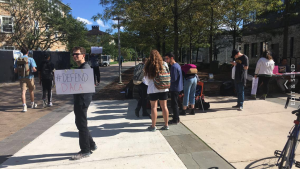
First, her friend Sabrina Nayar ‘18 sent out an informal invitation through the Facebook class pages to meet at Alice’s patio. “It started out with just 7 people but then people walked in,” Schutt said of the meeting. At first, students were calling for a walk-out the following day, but this particular method of mobilization was put into question by a few individuals at the table. Eventually, the group decided to call Robert Ferrell, a Goucher Communications staff member, regarded as a campus mentor and activist, for advice. “Rob brought out the point that if we do walk out now, people are going to associate it with Black Lives Matter (BLM),” Schutt told me. In 2015, in addition to leading a walk-out, Goucher students had led a die-in in front of academic buildings. Goucher had changed the listing of its address from “Baltimore” to “Towson” shortly after the Baltimore uprisings began, an act which many black students on campus saw as an affront to the BLM cause. The die-in made an impression on both administration and students alike. Pro-DACA mobilizers began to realized the importance of historical context when choosing appropriate methods of protest.
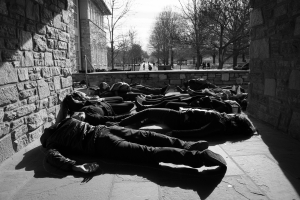
Students gathered together that afternoon realized that they themselves were not DREAMers, and that fighting for the program as allies carried different implications. “It was almost like [by walking-out] we would be appropriating [DREAMers]’ protest,” Schutt said. Important questions such as, “what is the proper way to respond to this event?,” “what is the most effective way of protesting?,” and “what message do we want to send?” had to be discussed. “We talked about intent vs impact, and the implications of our actions–like what [DREAMers] actually need and what that looks like,” Schutt told me. After more than three hours of conversation, Goucher students, cycling in and out of the meeting space, conceptualized a new plan for mobilization. “Our plan was to table and kind of disrupt the flow of Van Meter Highway,” Schutt told me.
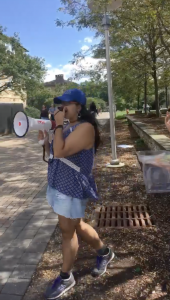
In the next few days, volunteers tabled in front of the main entrance of the Athenaeum, urging students to call their representatives. The way in which these students had decided to take matters into their own hands impressed me, and it reminded me of similar instances of student-led mobilization on campus. Over the course of my three years at Goucher, I had already witnessed students pushing for new student work policy reform. The semester before my first year, students led protests in response to police brutality against black Americans like Freddie Gray. Goucher has a legacy of students coming together on their own to stand up for what is important to them.
Yet, while I admired the ways my peers had organized the pro-DACA tabling all on their own, I noticed that many students avoid eye contact with the protesters and hastily walk past, which led me to question the success of the movement. Were they achieving the goals that they had set out to achieve? Brett Rapbaum, ‘20, while a pro-DACA student mobilizer herself, noticed some faux-pas in the way the movement attempted to create change. “It was like 10 people at the table at once, and it was a lot of first years who weren’t even aware of what DACA was,” she told me. While fruitful reflection and discussion had set the stage for the movement, it had been carried out by a decentralized group of people. Since no leadership structure existed, there was no system of accountability for misinformation, or consensus on proper tabling methods. “I heard lot of mega-phony type stuff, just like, ‘You can’t spare 2 minutes? Really?’,” Rapbaum said. As a Student Leader for Civic Action, Rapbaum has learned to avoid blaming people for not knowing something that they’ve never been taught. What she saw in some of the pro-DACA tabling was intimidation, not only of busy students who “wanted to be involved but couldn’t be in that moment,” but also of people who could have been informed about DACA and its importance. “It created enemies where they didn’t have to exist,” she explained. While she noted that the tabling did attract and motivate many students to action, she saw the movement’s tactics as effective in the short term but not so much in the long term. “This is an issue that’s going to be present for several months, and it’s dangerous to have something that’s sparked right away and then fizzles out,” she told me. “This is a long haul marathon, not a sprint.”
This is an endemic problem at Goucher. Student mobilization on campus often carries huge shock value and can spark very specific, short-term changes, but when it comes to long-term change, Goucher movements are faced with a variety of problems. About a year ago, students mobilized against a ‘New Student Work Policy’ announced in June – with great success. Yet the reason for its success was precisely predicated on its short-term goal: to revoke a policy that would restrict salaries for many students, particularly those who were international and/or of low-income. Ahmed Ibrahim ‘19 was one of the leaders of the movement. “I was very worried about what was going to happen with me staying on campus and working to meet the amount I needed to get my education. I knew people who worked on-campus and off-campus. This policy is going to screw them over. So what can we do about it?” Just like the pro-DACA mobilizers, Ibrahim met with other students working on campus over the summer who would be affected by the new policy. Some, like James Williams ‘19, had past experience affecting change, and they formed a core group of leaders. Williams helped the group form an incremental plan where their grievances would be expressed in increasingly visible and confrontational ways until the policy was revoked.
The group established some ground rules for their movement, such as complete transparency with students and administration. Most of the developments had occurred over the summer, so many students, particularly the incoming class, were out of the loop. Ibrahim informed students about the new policy by confronting people on Van Meter or in common rooms. Then, he and the rest of the group met with staff such as Karen Sykes and Luz Burgos-López.“[Their] summary was like yeah I hear you, but we can’t do anything about it because it was a joint decision by Goucher admin.” They took the next step. Williams sent out emails to administrators like Brian Coker and even José Bowen. “They responded. They were like, ‘yeah, we should have a discussion about it.’ Then it was a back and forth, like bargaining about it,” Ibrahim said. They pushed harder, directly confronting administrators like Leslie Lewis, LaJerne Cornish, and Emily Pearl during Student Employment Day. Administrators responded by suggesting an appeals process and encouraging student input.
Subsequently, the group used Facebook and tabling on Van Meter to collect signatures from students, staff, and faculty. Around 600 to 700 people signed their petition. The group then told administration that they would be meeting in the Athenaeum to engage in a more involved discussion about the policy with their peers. “I remember there were 7 us and then 35 people who joined,” Ibrahim told me. “We made a list of grievances on a board and took a picture, and we reflected on an appropriate course of action.” Here his story began to echo Schutt’s description of organizing the Pro-DACA movement. What was clearly different about Ibrahim’s account, however, was that an identifiable structure existed throughout the process. He and the rest of the core group leading the movement were able to convince administrators to convene with 10 to 12 students at a town hall meeting. “The agreement was ‘yes, we’re going to repeal the policy, but we’re also going to work with administration on a new policy’,” Ibrahim stated. Over the course of the next semester, student workers were able to create the more equitable work policy that exists today.
To be sure, the pro-DACA movement had its own successes. Schutt, Rapbaum, and a number of other mobilizers were able to identify key resources on campus that helped them inform and empower a large number of Goucher students. For example, they knew to go to CREI (Center for Race, Equity, and Identity), which supplied them with many of the flyers and print-outs that they handed out. They also coordinated with OSE (Office of Student Engagement), which provided additional information on DACA during common hour. Finally, they were able to identify key spaces for organizing and mobilizing more students. “We met in the P-Selz lobby, which is just like a really accessible space. It’s big, and there’s a projector that all students can use. We were able to send out mass emails, and also we were able to post on the Facebook pages about stuff,” Rapbaum told me. Some mobilizers even convinced a professor to bring their class to the DACA information table.
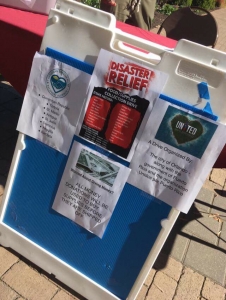
Yet, just as quickly as it had appeared, the pro-DACA movement melted away. As was seen with the movement against the New Student Work Policy, students from disparate groups tend to coalesce around certain issues, but not for long. Had the New Student Work Policy movement sought to change an economic policy beyond Goucher’s campus, it would have encountered many of the same problems that the pro-DACA movement faced. Goucher students thus lack the structure necessary to make the long-term changes they seek. Some, like Williams, have taken notice of this missing puzzle piece. “Ideally, we should have gotten more of a campus conversation about [mobilizing], because student activism stuff seems to pop up and go away really quickly,” he told me. The Goucher Leadership Council, a group of nominated student leaders, could have assumed the role of shaping a student network, but as Williams pointed out to me, it became more of an important ‘therapy space’ for leaders who are stretched thin. Having helped found the Radical Student Union (RSU), Williams hopes to achieve radical change on campus, but acknowledges the difficulties in doing so. “Some people start out and really start to spread agency of who’s going to do [the organizing]. But what ends up happening is, there’s so many people that have people in their pockets and nobody really knows who’s in charge, so the movement dissipates,” he explained. RSU members hold different views of what constitutes ‘radical change’, so the group hasn’t been able to agree on an effective system for student mobilization. That being said, the group has been working on building community. “Student mobilization needs to look like something where students come together – and clubs are dying, or if not dying, living in a silent-ish way,” Williams said.
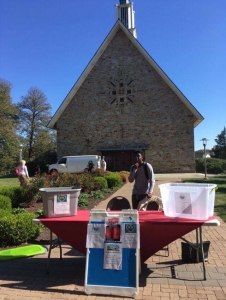
One group that has emerged out of Goucher’s past activism may be planting the seeds for the kind of consolidation Williams envisions. The Emergency Trump Task Force (ETTF) formed out of the pro-DACA movement when Usha Kaul ‘17 and seven other students decided that DACA’s revocation was only one of many Trump administration decisions that needed to be confronted. Zahir Mammadzada ‘21, one of the seven, questioned the effectiveness of shock-value protests. “Protests are effective to some point. Pressuring government bodies is more effective because shutting your mind off doesn’t really legally change anything.” Kaul chimed in, “often times I feel like people don’t understand the issue completely when protesting. They often just join the mass.” To Mammadzada and Kaul, ETTF serves as a pre-existing support structure of activists who will help table and inform when mobilized. When Kaul decided to create the Hurricane Relief Fund, she knew where to go. “We’re really pushing the whole ‘education and understanding the issue’ concept. We know that we can’t fix world problems 100%, but in order to move forward we need to educate people about the issues we’re facing,” she told me. Mammadzada added, “You’ve got to start somewhere!” Admittedly, ETTF’s political objectives are unlikely to draw in all of the Goucher student body. However, the group serves as a starting model for pulling the campus together, a process which, if ever completed, would empower students more than ever before.
